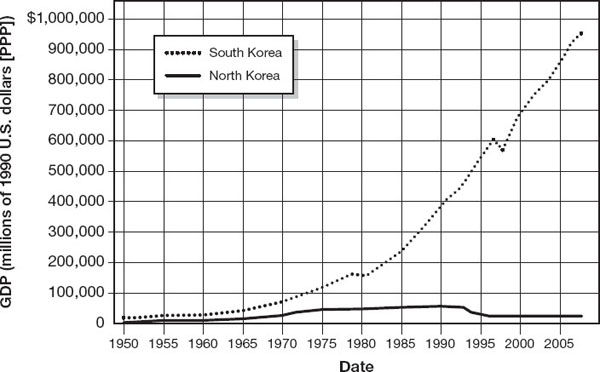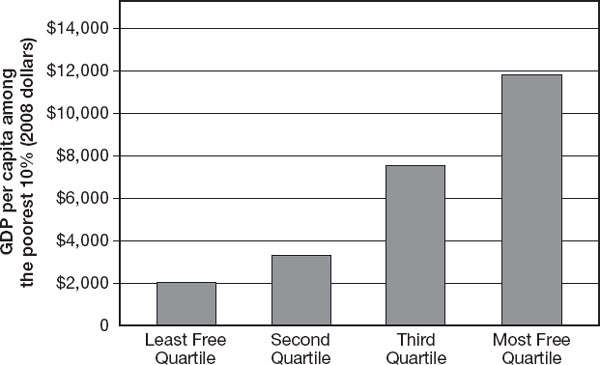The Road to Freedom (10 page)
Read The Road to Freedom Online
Authors: Arthur C. Brooks

How did the Industrial Revolution happen? How did the world become, if not rich, at least dramatically less poor than it had been two centuries earlier? The answer is free enterprise, or what philosopher Michael Novak calls “democratic capitalism.”
17
During the last two hundred years, there has been an unprecedented emergence of free societies and markets, accumulation of capital, and expansion of trade. The sudden emergence of free enterprise unleashed human creativity and ingenuity and brought about a previously inconceivable surge in living standards. Free enterprise is the reason that in two centuries, the world has progressed from an almost universally impoverished one to a world that is not.
Of course, there is still great poverty around the world. And here's the reason: free enterprise still has not spread widely enough. If you look at where poverty is disappearing fastest in the world, you'll find capitalism on the rise. According to the World Bank, China alone has accounted for more than 75 percent of poverty reduction in the entire developing world over the past two decades. How? This occurred not through communism, but through China's economic gains since Mao's death and its entry into world markets. From 1990 to 2006, just sixteen years, the inflation-adjusted value of Chinese exports to the United States increased by more than 1,000 percent.
18
According to the World Bank, 400 million Chinese were lifted out of absolute poverty between 1981 and 2001.
19
China has a long way to go to become a truly free and prosperous country, but the gains it
has
made have come from its experiments with capitalism.
Where has free enterprise been most elusive? In sub-Saharan Africa, home to the world's most impoverished countries. Africa's poorest countries include Burundi and the Democratic Republic of the Congo.
20
In these countries, citizens live on less than $1 per day.
21
Neither of these countries has a functional free enterprise system. Trade is restricted, property rights are weak, and markets are subverted by the government. Economists have shown again and again that this lack of economic freedom keeps people in poverty.
22
People have difficulty establishing private ownership of property, and bureaucratic systems make starting enterprises difficult or impossible. Low borrowing and investment mean little or no accumulation of capital, weak business formation, low job creation, and virtually no economic progress.
That is the real reason that misery persists in Africa, despite at least $1 trillion in foreign aid over the last fifty years.
23
Foreign aidâeven if it were administered in an efficient, noncorrupt wayâcannot
lift up more than a small percentage of a country's poor. To raise up a whole nation, a system that creates wealth, like America's, is needed. That system is free enterprise.
24
William Easterly, a professor of economics at New York University and one of the leading experts on international development, spent years researching how and why economies develop. He concluded that capitalism is the “good guy,” not the “bad guy.” He writes, “The number of poor people who can't afford food for their children is a lot smaller than it used to beâthanks to capitalism. Capitalism didn't create malnutrition, it reduced it.” Easterly adds that “profit-motivated capitalism is still the best case for the poor.”
25
The most compelling evidence for free enterprise comes from comparing similar countries that took different paths. Consider the case of North Korea and South Korea. One country embraced capitalism, while the other rejected it. Both Koreas were poor, and had the same GDP per capita just sixty years ago. Many socialists in the West believed that the North's Stalinist system of central planning would prove more effective than the South's market-based approach.
We all know how things turned out on the Korean peninsula. Today, North Korea is horribly poor and its people are starving. It also has the distinction of being the least free country in the world.
26
Meanwhile, South Korea is both the thirty-seventh freest country in the world and the thirteenth richest.
27
South Korea's GDP per capita is sixteen times that of North Korea.
28
Free enterprise means richer, healthier, and happier people worldwide. Each year, the “Economic Freedom Index” by The Fraser Institute (a Canadian think tank) ranks countries along forty-two dimensions, from personal choice in goods and services, to ease of voluntary exchange, to freedom to compete economically, to the security of privately owned property.
29
The index measures a country's degree of free enterprise. It finds that average citizens in economically free countries are prosperous, by world standards. In countries that are not free, people are poor.

Figure 4.2
. Comparative economic performance on the Korean Peninsula. (Source: Angus Maddison, “Statistics on World Population, GDP and Per Capita GDP, 1-2008 AD.” Groningen: The Groningen Growth and Development Centre. Available at
http://www.ggdc.net/MADDISON/Oriindex.htm
.)
In the freest nations (the top fifth), the average annual income is eighteen times that in the least-free nations (the lowest fifth). The problem is not that there is unequal distribution of money in the world. The problem is that there is unequal distribution of free enterprise.
But freedom doesn't just correlate with income; freer people are healthier too. In the freest countries, people live about twenty years longer, on average, than people in the least free countries. There's no surprise here, of course. Richer countries have better health care than poorer countries. Nevertheless, it is still worth pointing out that free enterprise and prosperity have huge human consequences.

Figure 4.3
. GDP per capita and life expectancy vary dramatically according to economic freedom between countries. (Source: James Gwartney, Joshua Hall, and Robert Lawson.
Economic Freedom of the World 2010 Annual Report.
Fraser Institute,
http://www.fraserinstitute.org/uploadedFiles/fraser-ca/Content/research-news/research/publications/economic-freedom-of-the-world-2010.pdf
; GDP per capita and life expectancy data are from the World Bank
World Development Indicators.
http://data.worldbank.org/indicator
[accessed 2011]
.)
Skeptics say that all this tells us nothing about whether free enterprise helps poor people
within
countries. Maybe capitalism raises the income for the top 1 percent significantly, while leaving the poor in desperate straits. That would still make the “average” citizen look richer, but it would make no difference for the poor. For example, if you and I start out with salaries of $50,000 and then you double your salary to $100,000 and I don't, our average salary rises to $75,000, but I'm no better off than I was.
However, if we look at the numbers a little more closely, the true picture emerges. The data show that the poorest 10 percent of citizens in the freest twenty countries earn about six times more than the poorest 10 percent in the least-free countries.

Figure 4.4
. The poor are best off in economically free countries. (Source: James Gwartney, Joshua Hall, and Robert Lawson
, Economic Freedom of the World 2010 Annual Report.
Fraser Institute.
http://www.fraserinstitute.org/uploadedFiles/fraser-ca/Content/research-news/research/publications/economic-freedom-of-the-world-2010.pdf
.)
These data show correlation, not causation, but there is no sleight of hand here. Many economists have proven that free enterprise
causes
prosperity by taking into account other explanations (like natural resources) and isolating the effects of free enterprise policies on economic growth. They have also indicated that growth follows freedom over time. And they have shown exactly how free enterprise rewards people for working hard and taking risks and, in turn, how this leads to wealth accumulation and prosperity for everyone.
30
FREE ENTERPRISE
creates growth and lifts up the rich and poor alike by giving entrepreneurs an incentive to create, earn their success, and keep the rewards. The prosperity passes to others because entrepreneurs generate jobs and growth, compete for
workers, and raise wages. Alternatively, when regulations are too harsh, the police are too corrupt, and the taxes are too punitive, there is little incentive to innovate and create. Poor people stay poor.
Rather than looking at the massive gains that free enterprise has created for the poor, critics complain that capitalism allows some people to get much richer than others, leading to the kind of economic inequality here in the United States. They're right; economic inequality is higher in America than it is in a country like Cuba. But surely this argument can't stand against the free enterprise system. Would you rather live in a place where everyone is very poor (except, maybe, a handful of kleptocrats who run the government)? Or in a place where everyone has a fairly high, basic standard of living, a handful of people have a lot more than others, and if you work hard and get lucky, you can join them?
Moreover, measures of income inequality radically overstate the true difference between economic classes in free societies. In 2009, the top fifth of American households had an average pretax income of $170,844, while the bottom fifth had an average income of $11,552.
31
This is a significant difference: The average income of the top fifth is sixteen times the average income of the bottom fifth. But let's look at consumption, what people actually do with the money they have. When we look at the money people actually lived on in 2009, we see that the wealthiest fifth of Americans spent less than five times what the poorest fifth spent.
32
Even more important than the equality in the amount of consumption is the equality in the
type
of consumption. One recent study of the American poor found that the average American household in poverty (as defined by the government) had air
conditioning, cable television, multiple TVs, and, if they had male children, an Xbox or PlayStation video-game console.
33
These modern conveniences are unthinkable in other parts of the world, but they are commonplace in America, even among lower-income groups.
Consider also that virtually everybody in America has a car. A few people own $200,000 Porsches, and many people own $10,000 used Kias. One may be more fun to drive, but both will get people to work. The cars are
functionally
nearly the same. In America and many other prosperous, free countries, both the billionaire and the manual worker own their own cars and have the freedom to travel around. That is the true miracle, and free enterpriseânot government edictâmade it so. Or, as the late Andy Warhol commented back in 1975: